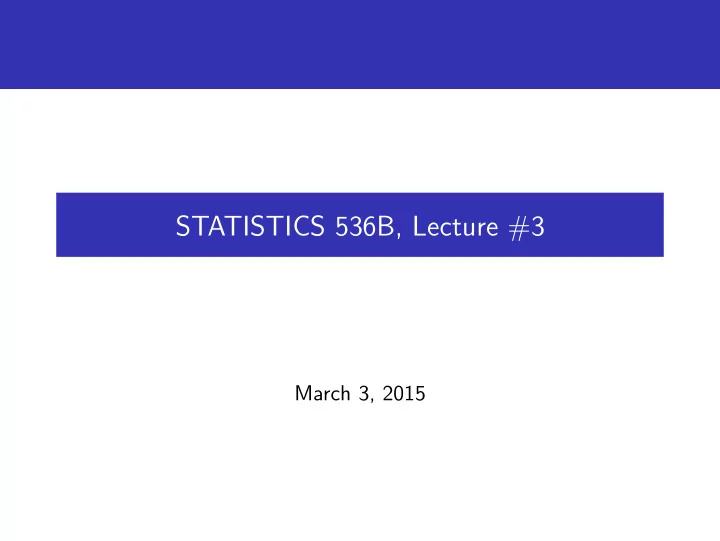

STATISTICS 536B, Lecture #3 March 3, 2015
General options for binary Y , binary X , confounders C = ( C 1 , . . . , C p ) • Build a logistic regression model for Y in terms of X and C • Think of the data “carved up” into a bunch of 2 × 2 ( Y , X ) mini data tables, one for each distinct value of C manifested in the data. For today’s lecture, will write m as the index to keep track of these mini-tables.
Demo: Generating and analyzing unmatched case-control data ### set up a population t <- 100000 set.seed(17) m.pop <- sample(0:6, size=t, prob=rep(1/7, 7), replace=T) x.pop <- rbinom(t, size=1, prob=expit(2 - (4/6)*m.pop)) y.pop <- rbinom(t, size=1, prob=expit(-3 + (4/9)*(m.pop-3)^2 + 0.5*x.pop))
Misspecified model messes up the controlling for confounders ### do a (balanced, unmatched) case-control study n <- 2000 set.seed(133) cs <- sample((1:t)[y.pop==1], size=n) cn <- sample((1:t)[y.pop==0], size=n) y <- c(y.pop[cs], y.pop[cn]) x <- c(x.pop[cs], x.pop[cn]) m <- c(m.pop[cs], m.pop[cn]) ### adjustment using main effect of m ft <- glm(y~x+m, family=binomial) Coefficients: Estimate Std. Error z value Pr(>|z|) (Intercept) -0.07383 0.08813 -0.838 0.402178 x 0.26231 0.07781 3.371 0.000749 *** m -0.02001 0.01792 -1.117 0.264118
Aside: what about no control, proper control glm(formula = y ~ x, family = binomial) Coefficients: Estimate Std. Error z value Pr(>|z|) (Intercept) -0.15838 0.04516 -3.508 0.000452 *** x 0.31269 0.06344 4.929 8.28e-07 *** glm(formula = y ~ x + m + I(m^2), family = "binomial") Coefficients: Estimate Std. Error z value Pr(>|z|) (Intercept) 1.84813 0.13277 13.920 < 2e-16 *** x 0.49335 0.10175 4.849 1.24e-06 *** m -2.81596 0.08521 -33.046 < 2e-16 *** I(m^2) 0.46643 0.01356 34.397 < 2e-16 ***
Adjust for confounding without modelling? dat.strfd <- table(y,x,m) > dat.strfd , , m = 0 x y 0 1 0 12 60 1 86 615 , , m = 1 x y 0 1 0 62 227 1 44 230 ... , , m = 6 x y 0 1 0 108 5 1 535 77
So have stratum-specific log-OR and SE ### function to get log-OR and SE from 2 by 2 table myfun.lor <- function(dattbl) { est <- log(dattbl[1,1])+log(dattbl[2,2])-log(dattbl[1,2])-log(dattbl[2,1]) se <- sqrt(sum(1/as.vector(dattbl))) c(est,se) } inf.strfd <- apply(dat.strfd, 3, myfun.lor) m 0 1 2 3 4 5 6 [1,] 0.358 0.356 0.563 0.713 0.661 0.328 1.134 [2,] 0.337 0.218 0.291 0.323 0.276 0.212 0.473
General statistical strategy for combining multiple estimators of the same target ests <- inf.strfd[1,] vars <- inf.strfd[2,]^2 whts <- (1/vars)/sum(1/vars) est.cmbd <- sum(whts*ests) se.cmbd <- sqrt(sum(whts^2*vars)) c(est.cmbd, se.cmbd) [1] 0.496 0.105
Homogeneity of (X,Y) odds-ratio across strata? We’ve assumed this. Empirically testable? > sum( (ests-est.cmbd)^2/vars ) [1] 3.891315
Or find a package... > library(epicalc) > mhor(mhtable=dat.strfd) Stratified analysis by m OR lower lim. upper lim. P value m 0 1.43 0.672 2.82 2.68e-01 m 1 1.43 0.912 2.25 1.07e-01 m 2 1.75 0.968 3.30 5.98e-02 m 3 2.04 1.045 4.11 3.08e-02 m 4 1.93 1.086 3.45 2.20e-02 m 5 1.39 0.896 2.15 1.35e-01 m 6 3.11 1.232 10.07 9.33e-03 M-H combined 1.67 1.362 2.05 8.22e-07 M-H Chi2(1) = 24.3 , P value = 0 Homogeneity test, chi-squared 6 d.f. = 3.91 , P value = 0.689
Is the Odds-Ratio also a collapsible measure of association? Example. Say the joint distribution of ( C , X , Y ) is characterized by: X and C are independent and identically distributed as Bernoulli(0.5) Pr ( Y = 1 X = 0 , C = 0) = 0 . 2 and Pr ( Y = 1 | X = 0 , C = 1) = 0 . 5 The stratified odds-ratios are OR ( Y , X | C = c ) = 4, for both c = 0 and c = 1. Is C a confounder? What is the crude odds-ratio OR ( Y , X )?
Recommend
More recommend